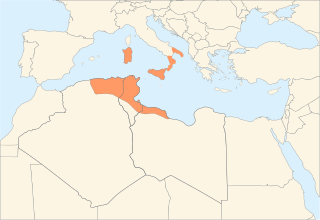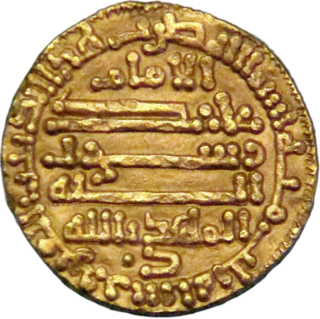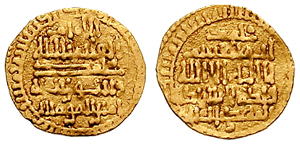Related Research Articles
The Fatimid dynasty was an Arab dynasty that ruled the Fatimid Caliphate, between 909 and 1171 CE. Descended from Fatima and Ali, and adhering to Isma'ili Shi'ism, they held the Isma'ili imamate, and were regarded as the rightful leaders of the Muslim community. The line of Nizari Isma'ili imams, represented today by the Aga Khans, claims descent from a branch of the Fatimids. The Alavi Bohras, predominantly based in Vadodara, also claim descent from the Fatimids.

The Aghlabid dynasty was an Arab dynasty centered in Ifriqiya from 800 to 909 that conquered parts of Sicily, Southern Italy, and possibly Sardinia, nominally as vassals of the Abbasid Caliphate. The Aghlabids were from the tribe of Banu Tamim and adhered to the Mu'tazilite rationalist doctrine within Hanafi Sunni Islam, which they imposed as the state doctrine of Ifriqiya. They ruled until 909 when they were conquered by the new power of the Fatimids.

Abū Muḥammad ʿAbd Allāh ibn al-Ḥusayn, better known by his regnal name al-Mahdī biʾllāh, was the founder of the Isma'ili Fatimid Caliphate, the only major Shi'a caliphate in Islamic history, and the eleventh Imam of the Isma'ili branch of Shi'ism.

Abu Tahir Isma'il, better known by his regnal name al-Mansur Billah, was the thirteenth Isma'ili imam and third caliph of the Fatimid Caliphate in Ifriqiya, ruling from 946 until his death. He succeeded his father, al-Qa'im, after the latter's death, in what was likely a bloodless palace coup. At the time of al-Mansur's accession, most of the Fatimid mainland realm in Ifriqiya had been lost to a large-scale anti-Fatimid revolt led by the Kharijite preacher Abu Yazid, who was laying siege to al-Qa'im's fortified coastal palace city of al-Mahdiya. Unlike his father he was an active and publicly visible monarch, but plagued by illness, which led to his early death.

Abū al-Qāsim Muḥammad ibn ʿAbd Allāh, better known by his regnal name al-Qāʾim (القائم) or al-Qāʾim bi-Amr Allāh, was the twelfth Isma'ili Imam and second caliph of the Fatimid dynasty, ruling in Ifriqiya from 934 to 946, succeeding his father Abd Allah al-Mahdi Billah.

Abu Ishaq Ibrahim II ibn Ahmad was the Emir of Ifriqiya. He ruled from 875 until his abdication in 902. After the demise of his brother, Ibrahim was endorsed as emir where he took steps to improve safety in his domain and secured the development of commercial activities. He improved public works, such as building a vast reservoir, erecting walls as well as the development of mosques and his Raqqada palace.

The island of Sicily was under Islamic rule from the late ninth to late eleventh centuries. It became a prosperous and influential commercial power in the Mediterranean, with its capital of Palermo serving as a major cultural and political center of the Muslim world.

The Muslim conquest of Sicily began in June 827 and lasted until 902, when the last major Byzantine stronghold on the island, Taormina, fell. Isolated fortresses remained in Byzantine hands until 965, but the island was henceforth under Muslim rule until conquered in turn by the Normans in the 11th century.

The navy of the Fatimid Caliphate was one of the most developed early Muslim navies and a major force in the central and eastern Mediterranean in the 10th–12th centuries. As with the dynasty it served, its history is in two phases. The first was c. 909 to 969, when the Fatimids were based in Ifriqiya ; the second lasted until the end of the dynasty in 1171, when they were based in Egypt. During the first period, the navy was employed mainly against the Byzantine Empire in Sicily and southern Italy, where it enjoyed mixed success. It was also in the initially unsuccessful attempts to conquer Egypt from the Abbasids and brief clashes with the Umayyad Caliphate of Córdoba.

The Battle of the Straits was fought in early 965 between the fleets of the Byzantine Empire and the Fatimid Caliphate in the Straits of Messina. It resulted in a major Fatimid victory, and the final collapse of the attempt of Emperor Nikephoros II Phokas to recover Sicily from the Fatimids.
Al-Hasan ibn Ali ibn Abi al-Husayn al-Kalbi, known in Byzantine sources as Boulchasenes and Aboulchare (Ἀβουλχαρέ), was the first Kalbid Emir of Sicily. A member of an aristocratic family within the ruling circle of the Fatimid Caliphate, he helped suppress the great revolt of Abu Yazid in 943–947 and was sent as governor of Sicily from 948 until 953, when he returned to Ifriqiya. He was succeeded in Sicily by his son Ahmad ibn al-Hasan al-Kalbi, but led several campaigns in Sicily and southern Italy against the Byzantines in 955–958, as well as the raid against Almeria that sparked a brief conflict with the Caliphate of Córdoba in 955. He died at Palermo in 964, during another campaign against the Byzantines.
ʿAmmar ibn ʿAlī ibn Abī al-Ḥusayn al-Kalbī was a member of the Kalbid family and a military commander for the Fatimid Caliphate in its wars with the Byzantine Empire in Sicily and southern Italy in the 950s.
The first Fatimid invasion of Egypt occurred in 914–915, soon after the establishment of the Fatimid Caliphate in Ifriqiya in 909. The Fatimids launched an expedition east, against the Abbasid Caliphate, under the Berber General Habasa ibn Yusuf. Habasa succeeded in subduing the cities on the Libyan coast between Ifriqiya and Egypt, and captured Alexandria. The Fatimid heir-apparent, al-Qa'im bi-Amr Allah, then arrived to take over the campaign. Attempts to conquer the Egyptian capital, Fustat, were beaten back by the Abbasid troops in the province. A risky affair even at the outset, the arrival of Abbasid reinforcements from Syria and Iraq under Mu'nis al-Muzaffar doomed the invasion to failure, and al-Qa'im and the remnants of his army abandoned Alexandria and returned to Ifriqiya in May 915. The failure did not prevent the Fatimids from launching another unsuccessful attempt to capture Egypt four years later. It was not until 969 that the Fatimids conquered Egypt and made it the centre of their empire.
Ahmadibn al-Hasan al-Kalbi was the second Kalbid Emir of Sicily. He was the son of the first Kalbid emir, al-Hasan ibn Ali al-Kalbi, who ruled the island on behalf of the Fatimid Caliphate. Ahmad succeeded his father in May 953 until 968, apart from a brief interruption in 958/9. In the 960s, he led the completion of the Muslim conquest of Sicily by capturing the last Byzantine strongholds of Taormina and Rometta and defeating a Byzantine relief expedition. He was recalled to Ifriqiya to participate in the upcoming Fatimid conquest of Egypt, and died there shortly after.
Al-Hasan ibn Ahmad ibn Abi Khinzir was a Fatimid military commander who served as the first Fatimid governor of Kairouan and of Sicily.
Ali ibn Umar al-Balawi was a short-lived Fatimid governor of Sicily in 912–913.
Salim ibn Asad ibn Abi Rashid was the governor of Sicily for the Fatimid Caliphate for twenty years, from 917 to 937.
Khalil ibn Ishaq al-Tamimi was a Sunni Arab military commander, in the service of the Fatimid Caliphate as head of the Arab jund of Ifriqiya. He was active as early as 913. From 937 to 941 he was the governor of Sicily, leading the brutal suppression of a large-scale anti-Fatimid revolt. He was captured and killed in 944, during the anti-Fatimid rebellion of Abu Yazid.

Niketas, possibly surnamed Abalantes, was a Byzantine military commander who in 964 led a major expedition against the Fatimid Caliphate in Sicily, was defeated, and spent a few years in captivity, where he copied the Codex Parisinus gr. 497 manuscript.

The siege of Taormina in 902 ended the conquest of the Byzantine city of Taormina, in northeastern Sicily, by the Aghlabids. The campaign was led by the deposed Aghlabid emir, Ibrahim II, as a form of armed pilgrimage and holy war. Ibrahim's forces defeated the Byzantine garrison in a hard-fought battle in front of the city walls, and laid siege to the city. Left unsupported by the Byzantine government, Taormina capitulated on 1 August. The population was massacred or sold into slavery. The fall of this last major Byzantine stronghold signalled the completion of the Muslim conquest of Sicily, which had been ongoing since the 820s, although some minor Byzantine outposts survived until the 960s.
References
- 1 2 3 4 Halm 1991, p. 164.
- ↑ Halm 1991, pp. 163–164.
- 1 2 3 4 Metcalfe 2009, p. 47.
- 1 2 3 4 5 6 7 PmbZ , Aḥmad b. Ziyādatallāh b. Qurhub (#20191).
- 1 2 3 4 5 6 7 8 Halm 1991, p. 166.
- ↑ PmbZ, Aḥmad b. Ziyādatallāh b. Qurhub (#20191); Eustathios (#21845).
- 1 2 Halm 1991, p. 213.
- ↑ Halm 1991, p. 167.
- ↑ Metcalfe 2009, pp. 47–48.